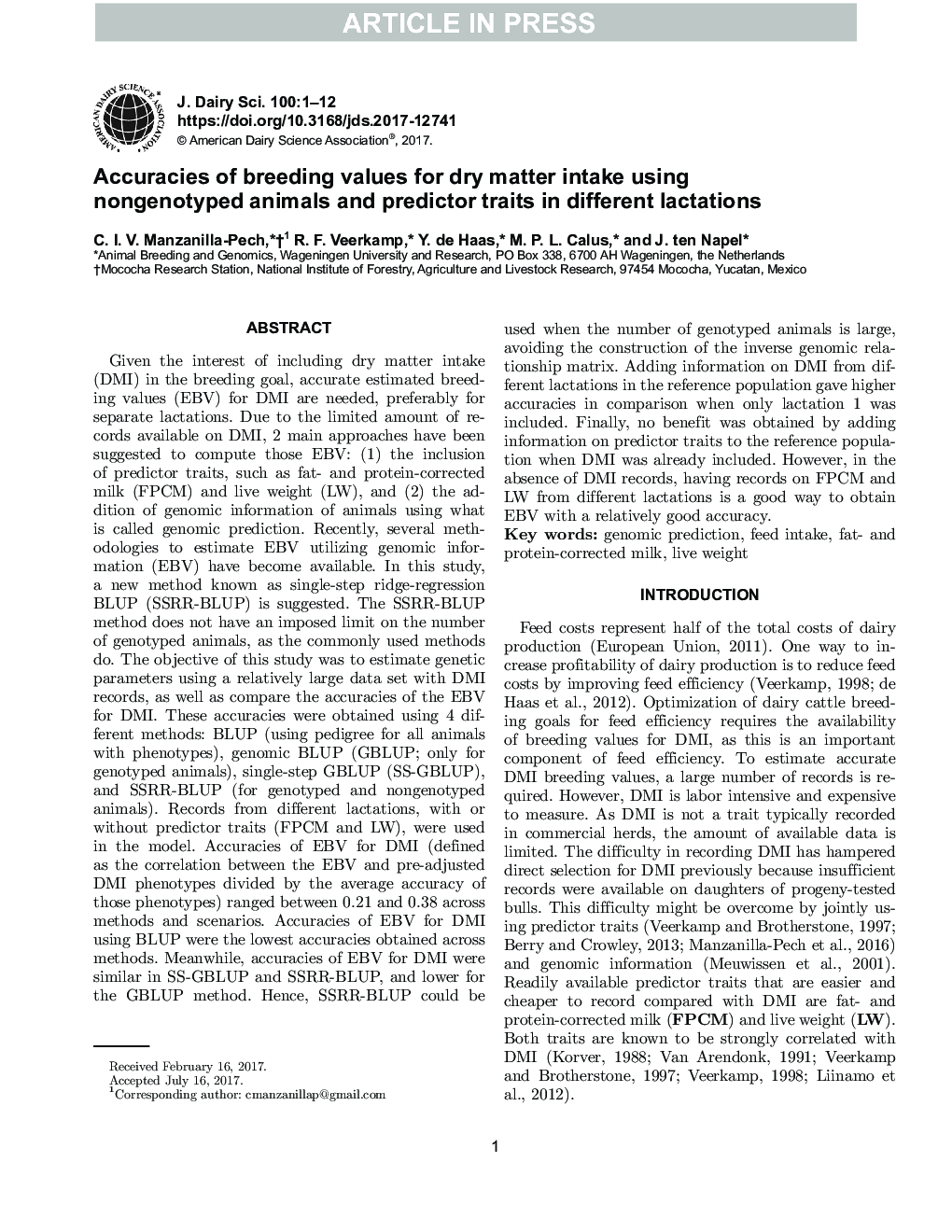| کد مقاله | کد نشریه | سال انتشار | مقاله انگلیسی | نسخه تمام متن |
|---|---|---|---|---|
| 5541678 | 1553846 | 2017 | 12 صفحه PDF | دانلود رایگان |
عنوان انگلیسی مقاله ISI
Accuracies of breeding values for dry matter intake using nongenotyped animals and predictor traits in different lactations
ترجمه فارسی عنوان
دقت مقادیر پرورش برای مصرف ماده خشک با استفاده از حیوانات نابالغ و خواص پیش بینی کننده در شیردهی های مختلف
دانلود مقاله + سفارش ترجمه
دانلود مقاله ISI انگلیسی
رایگان برای ایرانیان
کلمات کلیدی
پیش بینی ژنوم، مصرف خوراک، چربی و پروتئین اصلاح شیر، وزن زنده
موضوعات مرتبط
علوم زیستی و بیوفناوری
علوم کشاورزی و بیولوژیک
علوم دامی و جانورشناسی
چکیده انگلیسی
Given the interest of including dry matter intake (DMI) in the breeding goal, accurate estimated breeding values (EBV) for DMI are needed, preferably for separate lactations. Due to the limited amount of records available on DMI, 2 main approaches have been suggested to compute those EBV: (1) the inclusion of predictor traits, such as fat- and protein-corrected milk (FPCM) and live weight (LW), and (2) the addition of genomic information of animals using what is called genomic prediction. Recently, several methodologies to estimate EBV utilizing genomic information (EBV) have become available. In this study, a new method known as single-step ridge-regression BLUP (SSRR-BLUP) is suggested. The SSRR-BLUP method does not have an imposed limit on the number of genotyped animals, as the commonly used methods do. The objective of this study was to estimate genetic parameters using a relatively large data set with DMI records, as well as compare the accuracies of the EBV for DMI. These accuracies were obtained using 4 different methods: BLUP (using pedigree for all animals with phenotypes), genomic BLUP (GBLUP; only for genotyped animals), single-step GBLUP (SS-GBLUP), and SSRR-BLUP (for genotyped and nongenotyped animals). Records from different lactations, with or without predictor traits (FPCM and LW), were used in the model. Accuracies of EBV for DMI (defined as the correlation between the EBV and pre-adjusted DMI phenotypes divided by the average accuracy of those phenotypes) ranged between 0.21 and 0.38 across methods and scenarios. Accuracies of EBV for DMI using BLUP were the lowest accuracies obtained across methods. Meanwhile, accuracies of EBV for DMI were similar in SS-GBLUP and SSRR-BLUP, and lower for the GBLUP method. Hence, SSRR-BLUP could be used when the number of genotyped animals is large, avoiding the construction of the inverse genomic relationship matrix. Adding information on DMI from different lactations in the reference population gave higher accuracies in comparison when only lactation 1 was included. Finally, no benefit was obtained by adding information on predictor traits to the reference population when DMI was already included. However, in the absence of DMI records, having records on FPCM and LW from different lactations is a good way to obtain EBV with a relatively good accuracy.
ناشر
Database: Elsevier - ScienceDirect (ساینس دایرکت)
Journal: Journal of Dairy Science - Volume 100, Issue 11, November 2017, Pages 9103-9114
Journal: Journal of Dairy Science - Volume 100, Issue 11, November 2017, Pages 9103-9114
نویسندگان
C.I.V. Manzanilla-Pech, R.F. Veerkamp, Y. de Haas, M.P.L. Calus, J. ten Napel,
